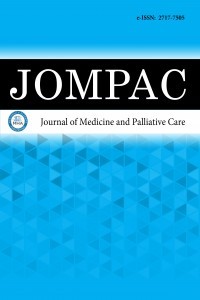Ülseratif kolitte hastalığın şiddetini öngörmede non-invaziv belirteçler olarak hematolojik parametrelerin değerlendirilmesi
ülseratif kolit, hastalık aktivitesi, nötrofillerin lenfosit ve plateletlere oranı, nötrofil-lenfosit oranı
Evaluation of hematological parameters as non-invasive markers in predicting the severity of the disease in ulcerative colitis
Ulcerative colitis , disease activity, neutrophil to lymphocyte and platelet ratio, neutrophil–lymphocyte ratio,
___
- Younis N, Zarif R, Mahfouz R. Inflammatory bowel disease: between genetics and microbiota. Mol Biol Rep 2020; 47: 3053-63.
- Beyazit Y, Sayilir A, Tanoglu A, et al. Plasma thrombin-activatable fibrinolysis inhibitor levels correlate with the disease activity of ulcerative colitis. Intern Med 2016; 55: 1831-6.
- Walsh A, Kormilitzin A, Hinds C, et al. Defining faecal calprotectin thresholds as a surrogate for endoscopic and histological disease activity in ulcerative colitis-a prospective analysis. J Crohns Colitis 2019; 13: 424-30.
- Sandborn WJ, Loftus EV Jr, Colombel JF, et al. Evaluation of serological disease markers in a population-based cohort with ulcerative colitis and Crohn’s disease. Inflamm Bowel Dis 2001; 7: 192-201.
- Lewis JD. The use of biomarkers in the diagnosis and treatment of inflammatory bowel disease. Gastroenterology. 2011; 140: 1817-26.
- Schoepfer AM, Beglinger C, Straumann A, et al. Fecal calprotectin more accurately reflects endoscopic activity of ulcerative colitis than the lichtiger index, c-reactive protein, platelets, hemoglobin, and blood leukocytes. Inflamm Bowel Dis 2013; 19: 332-41.
- Xue TC, Zhang L, Xie XY, et al. Prognostic significance of the neutrophil-to-lymphocyte ratio in primary liver cancer: a meta-analysis. PLoS One 2014; 9: e96072.
- Torun S, Tunc BD, Suvak B, et al. Assessment of neutrophil-lymphocyte ratio in ulcerative colitis: a promising marker in predicting disease severity. Clin Res Hepatol Gastroenterol 2012; 36: 491-7.
- Koo CH, Eun Jung D, Park YS, et al. Neutrophil, lymphocyte, and platelet counts and acute kidney injury after cardiovascular surgery. J Cardiothorac Vasc Anesth 2018; 32: 212-22.
- Gameiro J, Fonseca JA, Jorge S, Gouveia J, Lopes JA. Neutrophil, lymphocyte and platelet ratio as a predictor of mortality in septic-acute kidney injury patients. Nefrologia 2020: 40: 461-8. Online ahead of print.
- Ryzko J, Woynarowski M. evaluation of nonspecific inflammatory bowel disease in children using disease activity scoring systems. Pediatr Pol 1995; 70: 569-73.
- Mohammed Vashist N, Samaan M, Mosli MH, et al. Endoscopic scoring indices for evaluation of disease activity in ulcerative colitis. Cochrane Database Syst Rev 2018; 1: CD011450.
- Henderson AR. Assessing test accuracy and clinical results: a primer for receiver study characteristic curve analysis. Ann Clin Biochem 1993; 30: 521-39.
- Makkar R, Bo S. Colonoscopic perforation in inflammatory bowel disease. Gastroenterol Hepatol 2013; 9: 573-83.
- Karagoz E, Tanoglu A. Clinical importance of serum procalcitonin in ulcerative colitis patients World J Gastroenterol 2014; 20: 15941-2.
- Akpınar M, Ozin Y, Kaplan M, et al. Platelet-to-lymphocyte ratio and neutrophil-to-lymphocyte ratio predict mucosal disease severity in ulcerative colitis. J Med Biochem 2018; 37: 155-62.
- Gewirtz AT, Liu Y, Sitaraman SV, Madara JL. Intestinal epithelial pathobiology: past, present and future. Best Pract Res Clin Gastroenterol 2002; 16: 851-67.
- Qin X. Etiology of inflammatory bowel disease: A combined hypothesis. World J Gastroenterol 2012; 18: 1708-22.
- Vermeire S, Van Assche G, Rutgeerts P. Laboratory markers in IBD: useful, magic or unnecessary toys? Gut 2006; 55: 426-31.
- Demir AK, Demirtaş A, Kaya SU, et al. The relationship between the neutrophil-lymphocyte ratio and disease activity in patients with ulcerative colitis. Kaohsiung J Med Sci 2015; 31: 585-90.
- Başlangıç: 2020
- Yayıncı: MediHealth Academy Yayıncılık
Türkiye’de yetişen Teucrium polium L. bitkisinin HepG2 hücre hattı üzerindeki etkisi
Nur SANCAK, Duygu KIRKIK, Jalal ALRAGABİ
Palyatif bakıma bakış ve hemşireliğin rolü
Psikotropik ilaçlar ve hiponatremi ilişkisi: bir derleme
Murat YENİÇERİ, Başak ÇAKIR GÜNEY, İrfan KÜÇÜK, Muammer KARA, Yusuf YAZGAN, Mustafa KAPLAN
Palyatif bakım hastalarında yetersiz beslenme durumunun belirlenmesi
Derya BIÇAK AYIK, Zeliha BÜYÜKBAYRAM, Gülbeyaz CAN
Otoimmün tiroid hastalıklarında CTLA-4 geninin in silico analizinin değerlendirilmesi
Duygu KIRKIK, Sevgi KALKANLI, Eylem ÇAĞILTAY, Nevin KALKANLİ
